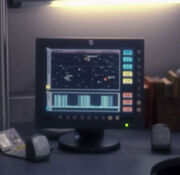
A 22nd century desktop monitor, displaying pulsar frequencies
A desktop monitor is a personal computer console used as early as 2151 aboard starships and starbases by space-faring organizations such as Earth Starfleet and the Federation Starfleet, the Klingon Empire and the Cardassian Union. These devices were used for personal library computer retrieval and for visual communications.
Desktop monitors were also commonly used by civilians living on such planets as Earth, Romulus and Cardassia.
Earth Starfleet
During the 22nd century, Earth Starfleet employed at least two styles of desktop monitor aboard its deep space vessels and at Starfleet Headquarters.
Flat panel monitor
A flat-panel, 22nd century monitor
Used aboard such vessels as the NX-class starship Enterprise as early as 2151, flat panel monitors - similar to those utilized in the bridge consoles - were placed in all officers' quarters.
Consisting of a simple touch-sensitive screen, this flat panel monitor was distinguished by two rows of gray and white buttons lining the bottom and left-hand side of the screen.
As in future incarnations, this monitor allowed the user a wide variety of data retrieval as well as log recording, and access to subspace communications, enabling face-to-face conference.
These monitors were also in use at Starfleet Headquarters, San Francisco, Earth, during the 22nd century. (ENT: "Broken Bow")
- The monitors seen mounted on the bulkheads and consoles on Enterprise, as well as those used by Captain Archer and his crew in their quarters, were simple plasma screen monitors, owned today by many PC users. These monitors cost the producers around $4,000 (US) each (according to Star Trek Communicator magazine) and were simply decorated to look futuristic. The power indicator lights (either blue or green) are clearly visible on most of the screens aboard Enterprise as are small strips of black tape used to cover the brand name label. The buttons lining the monitors are also commercially available - they are 3M Tapered Square Bumpons, adhesive-backed polyurethane buttons that can be used as feet for items that might scratch the surfaces they are placed upon. The small silver and blue jewel at the top center of the monitor is believed to be a camera, though this has never been explicitly stated.
Three-sided monitor
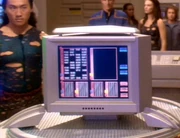
A tri-sided viewer at CS-12
Also used at Earth Starfleet Headquarters, San Francisco as early as 2154 was a distinct, three-sided monitor.
Found in conference rooms, this multifaceted monitor featured three display screens, arranged in a triangular shape and allowing multiple users to view data simultaneously. It also featured a touch-sensitive screen and a small row of buttons just beneath the display. (ENT: "Home")
A similar monitor was located at the center of a large console in the main laboratory of Cold Station 12. (ENT: "Cold Station 12", "The Augments")
- A throwback to The Original Series, this three-sided monitor appeared four times on Enterprise, clearly intended to be the predecessor of the monitor seen on TOS.
- In its first appearance, during Captain Archer's debriefing at Headquarters following his return home from the conflict with the Xindi, the monitor sat on a tall base and featured several buttons, both elements not present during its appearances in the main laboratory of CS-12. It was later used (again sans base and sans buttons) in "In a Mirror, Darkly, Part II", as a 23rd century monitor aboard the Defiant.
Federation Starfleet
Throughout the 23rd and 24th centuries, the United Federation of Planets and its Starfleet utilized varying styles of monitors, some based on function, with others differing only in aesthetics.
23rd century
Standard monitor
Viewer displaying a tech journal
A standard desktop monitor employed as early as 2366 aboard such Federation vessels as the USS Enterprise, and at the Janus VI colony, was a large, free-standing model.
Sitting on a heavy base in which tapes could be inserted, this desktop viewer featured a large monitor, blue-gray in color. (TOS: "Devil in the Dark", "The Menagerie, Part I", "The Trouble with Tribbles")
Three-sided monitor
Also in service aboard Constitution-class starships, a three-sided monitor, similar in design to those used a century earlier by Earth Starfleet, was often found in a Federation starship's briefing room.
Resembling the top portion of the single-faceted viewer, this three-sided monitor featured screens facing away from each other in three directions and sat on a conference table aboard such ships as the Enterprise. It could be controlled by button pads embedded in the tabletop. (TOS: "Mudd's Women")
24th century
Galaxy-class
Common aboard Galaxy-class starships such as the Enterprise-D - as well as other ships commissioned during the 2360s - a black-and-white monitor was available for use in many personal spaces aboard ship.
Used in such areas as crew quarters and in the captain's ready room, these small desktop monitors were often black-and-white, or white-and-black in color. Marked by a square, touch sensitive monitor and a rounded keyboard area, these monitors were distinguished by white or black buttons and white or black stripes.
These monitors were capable of a wide variety of functions, utilizing the LCARS network common aboard Starfleet vessels in the 24th century. They were also sometimes used for secure communications. (TNG: "Encounter at Farpoint")
When William T. Riker was affected by Barclay's Protomorphosis Syndrome and turned into a Neanderthal, he threw Picard's desktop monitor at the Captain, thereby breaking the device in half. (TNG: "Genesis")
- While Captain Picard was most often seen using his black desktop interface in his ready room, white monitors were located in Doctor Crusher's office in sickbay as well as in Counselor Troi's office. These monitors were used exclusively on The Next Generation, seen not only on the Enterprise-D, but also the USS Yamato in "Contagion" (albeit the white variety), USS Phoenix in "The Wounded" and in Marla Aster's home on Earth in "The Bonding".
- The structure of the monitor was used as the basis for several alien monitors, including the Romulan and Cardassian monitors listed below. It also served as Baran's monitor in "Gambit, Parts I and II" and as a "future" model aboard the USS Pasteur in "All Good Things...". After TNG the model represented only alien computers appearing again as a Romulan monitor in "Improbable Cause", as a Ferengi computer in "Business as Usual" and "The Dogs of War", as an Ocampan viewer in "Cold Fire", as Bilby's monitor in "Honor Among Thieves", as an illusory Federation model in "Extreme Measures", as a Telsian computer in "Live Fast and Prosper", as a Bajoran device in "Repression", and as a Quarran computer in "Workforce, Part II".
- The last remaining TNG monitor was sold at the 40 Years of Star Trek: The Collection auction. It had been painted brown and was no longer recognizable as a Federation monitor.
Starbases
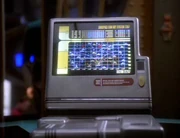
Benjamin Sisko's desktop monitor at DS9
Utilized by Starfleet personnel serving on Federation starbases and at Federation colonies such as starbase Deep Space 9, Starbase 375, Jupiter Station, and the Volon III colony, a large desktop monitor was available as early as 2369.
Metallic silver in color, this style of monitor featured an irregular, square shape with display and input areas of roughly the same size. Some models featured additional button pads as well as ports capable of reading isolinear rods.
Despite the common use of other styles of desktop viewer, this type was available for use aboard such Starfleet vessels as the Intrepid-class USS Bellerophon and at Starfleet Headquarters. (DS9: "Dax", "The Maquis, Part I", "Homefront", "Paradise Lost", "A Time to Stand", and more; VOY: "Life Line")
- There is no established, in-universe reason why Deep Space 9 personnel seemed to only use this style of monitor, even when they weren't on Deep Space 9. Slight variations of the monitor were used throughout the run of DS9, with varying labels and plant-on details.
- The DS9 desktop monitor appeared after the end of that series, in Doctor Lewis Zimmerman's office on Jupiter Station in "Life Line", and was later redressed to serve as a Dinaali monitor in the Star Trek: Voyager episode "Critical Care", and as a Torothan computer in Enterprise, "Desert Crossing".
Intrepid-class
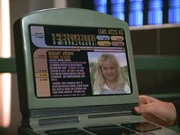
A green monitor aboard the USS Voyager
In service during their launch during the early 2370s, Intrepid-class starships such as the USS Voyager were equipped with yet another style of desktop monitor.
Ranging in color from gray to green, these monitors were also used in personal areas, as well as in sickbay and consisted of a rounded design, consistent with the aesthetics of the Intrepid-class. VOY: "Caretaker")
- The Voyager personal computers varied in color, often from season to season. From season one to the end of season three, Captain Janeway's monitor was gray in color, changing to green for the final four seasons. A blue-gray version of the monitor sat in sickback, with a dark-gray version populating crew quarters.
- A green model of the monitor was sold during the 2006 40 Years of Star Trek auction, described in the catalog as, "A simulated desktop computer monitor, grey-green case with bottom marked Ready Room and Janeway's quarters, ready room, lighting circuit would illuminate a backlit graphic transparency to create simulated computer image on the screen [untested], included acrylic plastic insert for graphic, includes spare rechargeable battery and charger - 12 1/2 x 11 1/2 x 11 1/2 in. - used as set dressing on Captain Janeway's ready room desk in Star Trek: Voyager. This prop was featured in the captain's ready room and her quarters, and thus is the most significant of these computers."
Sovereign-class

A monitor in use aboard the Enterprise-E in 2373
For officers serving aboard Sovereign-class vessels in the 2370s, at least two styles of monitor was available for use by Starfleet officers.
One such style featured a monitor that laid flush against its base, rising up when activated by the user, or when receiving an incoming communique. Such a monitor was used by Enterprise-E captain Jean-Luc Picard as early as 2373 until it was replaced some time around 2375 by a stationary model. (Star Trek: First Contact; Star Trek: Insurrection)
- Captain Picard's stationary monitor was created, according to Terry J. Erdmann's The Secrets of Star Trek: Insurrection, because its First Contact counterpart took so long to move up and down.
By the year 2379, both such desktop monitors had been replaced in the captain's ready room by a single, flat-panel viewer that existed as part of the desktop and rose up when activated from a small control panel embedded in the desk.
In use aboard Sovereign-class quarters during that time was yet another style of flat-panel monitor, this one free-standing and silver in color. (Star Trek Nemesis)
- With the advent of plasma screen monitors about the size of the non-functional desktop monitor props of TNG, DS9 and Voyager, the producers of Star Trek Nemesis incorporated them into the sets of the Enterprise-E. Slightly larger in size than the monitors seen in the preceding two films, these plasma screens were functional, allowing more action to take place on screen.
Earth civilian

The Picard family monitor displaying Atlantis project schematics
As early as 2367, desktop monitors used by civilians living on Earth in some intances consisted of brownish-gray consoles with square-shaped displays and an abundance of buttons and touchpads.
These monitors were roughly the size of those used aboard Federation starships at the time and served the same basic function, if bearing a less stylized design. (TNG: "Family")
- The computer console located at the Picard family home and vineyard in La Barre, France, could have represented an older design, as the house and its contents were generally old-fashioned. The layout and style of the graphics seen on screen in "Family" suggest that it was not Starfleet issue.
Romulan
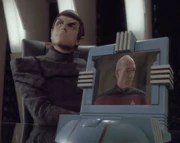
Sharing many of the same design features as the monitors used aboard the Galaxy-class starship of the 2360s, members of the Romulan Senate had at least one type of desktop monitor at their disposal as early as 2368.
As with many things Romulan, this desktop viewer was green in color and featured several square blocks added onto its strucutre and an irregularly-shaped disply screen. (TNG: "Unification, Parts I" & "II")
- The Romulan-type desktop monitor was clearly a modified version of the TNG-style monitor, repainted and disguised with several added components. It is possible the Romulans stole this design from the Federation, or that this is simply a popular design in the 2360s.
Cardassian
Like the Federation in the 24th century, the more than one type of desktop monitor was available to civilians and military personnel in the Cardassian Union.
Small monitor
A small Cardassian monitor.
Also sharing similarities with the Federation design used aboard Galaxy-class vessels at the time, Cardassian military officers like those serving at the secret base on Celtris III used a distinctive desktop monitor.
Like the Romulan design, this monitor featured the same basic shape as the Federation design, enhanced stylistically with typical Cardassian brown and tan coloration and large structural changes. The display screen, for example, featured a large oval-shaped frame and was larger than its Starfleet issue counterpart. (TNG: "Chain of Command, Part I", "Chain of Command, Part II")
- Yet another clear example of a recycled prop, the Cardassian monitor was most likely a redress of the Romulan monitor from "Unification", which itself was a redress of the TNG-style desktop. It would appear only in "Chain of Command" and would be replaced in DS9 by a uniquely Cardassian design. Doctor Tolen Ren and Teero Anaydis used similar, though repainted monitors in VOY "Ex Post Facto and "Repression".
Desktop viewscreen
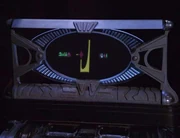
A Cardassian monitor displaying a message from the Dominion
Similar to the typical viewscreen used aboard Terok and Empok Nor-type space stations and Galor-class cruisers, a second style of Cardassian monitor utilized a holographic projection system as early as 2369.
Resembling the larger, frame-like viewscreens in service around the 2360s and 70s, this desktop viewscreen consisted of a horizontal-rectangular shaped structure, mostly hollow, until active. The image of the communique would then appear within the oval-shaped frame, until deactivation.
Such a device was in service aboard starbase Deep Space 9, even after Cardassian withdrawl, and on Cardassia Prime. (DS9: "Past Prologue", "The Dogs of War")
- This distinct monitor appeared only a few times on DS9, even appearing on Captain Sisko's desk before being replaced with the Starfleet issue terminal that remained through the run of the series.
- As this type was seen in the possession of Mila, a civilian, it is possible that it is military issue, as Mila's house once belonged to Obsidian Order head, Enabran Tain.
Klingon
A Klingon monitor.
Like much of the equipment in use aboard Imperial Klingon starships, the desktop monitors in the living quarters aboard Birds-of-Prey (like the one commanded by Captain K'Vada in 2368) were brown in color.
Similar in design to Earth civilian desktop monitors, these Klingon devices were generalized in shape, bearing a display screen and keyboard area. Unlike Earth devices, however, the Klingon monitor utilized knobs and buttons, rather than touch-sensitive surfaces.
Other monitors utilized by the Klingon Empire consisted of free-standing computer screens. (TNG: "Unification, Part II")
- Among the consoles used by Data and Spock in "Unification, Part II" was the console seen at the Picard family home in "Family", repainted and bearing large, unwieldy knobs.
See Also
- Optical Data Net service access
- Template:Exastris
- Template:Exastris
- Template:Exastris
